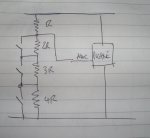buntay
Senior Member
Good morning picaxe friends,
I am using the picaxe 28 project board and i don't have enough input pins so I am planning on reading several (no more than 4) inputs on the same pin using different resistance levels and the ADC command.
Now I know that ambient and load resistor temperature will have an affect on its resistance, is there a formula to use to give a span in the code? These will be pretty crucial inputs so this needs to be compensated for.
any thoughts?
I am using the picaxe 28 project board and i don't have enough input pins so I am planning on reading several (no more than 4) inputs on the same pin using different resistance levels and the ADC command.
Now I know that ambient and load resistor temperature will have an affect on its resistance, is there a formula to use to give a span in the code? These will be pretty crucial inputs so this needs to be compensated for.
any thoughts?


